Roaming around a Roman treasure
Off to Pompeii. We had obviously upset the Roman Gods, somehow, because as we set off on the train from Sorrento it began to rain in torrents. The great Vesuvius was hidden by mist and clouds. Water everywhere and people too. The roads, paved with Vesuvian stone, were underwater—it felt a bit like rock pooling on Bamburgh beach.
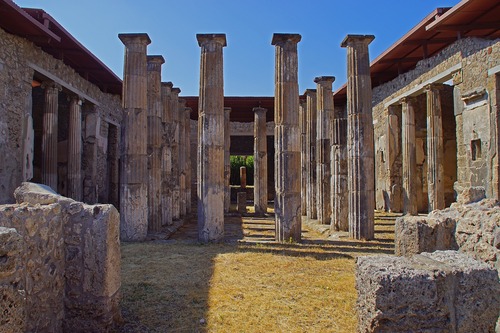 Over 3 million visit Pompeii each year and it appeared that most were here today. Hordes of people splashing water everywhere. And, of course, Japanese coach parties running from one photographic site to another. Sightseeing at a pace. Very few with coats, never mind umbrellas.
Over 3 million visit Pompeii each year and it appeared that most were here today. Hordes of people splashing water everywhere. And, of course, Japanese coach parties running from one photographic site to another. Sightseeing at a pace. Very few with coats, never mind umbrellas.
We had come prepared. If the Roman army could live for years along Hadrian’s Wall wearing nothing more than flimsy Italian designer clothing then a good old British brolly should do the trick in Pompeii. And we were unlucky with the weather; it’s more often beautifully warm and sunny.
Pompeii is amazing. The visual drama is intense. Rough and rugged, beautiful and so atmospheric. The eruption of Vesuvius in AD 79 flung a deep, protective blanket of pumice over the whole town and its surrounding landscape. It lay completely buried for centuries and was only rediscovered in the 1700’s. Brought back to life from its ash-filled grave, it continues to reveal discoveries of unparalleled value and breathtaking detail.
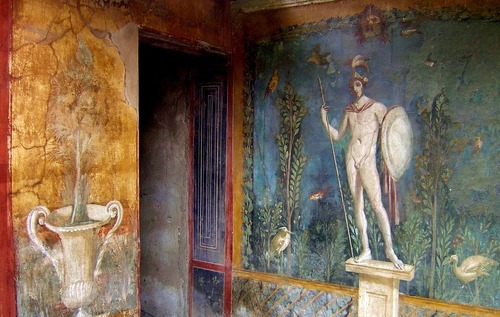 To many, Pompeii is just a load of ruins, but for others, me included, this UNESCO World heritage site represents everything that the Romans gave to the world. As we walked the history of these remarkable people, and as the rain began to soak into our DNA (and jeans!) Pompeii began to work its magic.
To many, Pompeii is just a load of ruins, but for others, me included, this UNESCO World heritage site represents everything that the Romans gave to the world. As we walked the history of these remarkable people, and as the rain began to soak into our DNA (and jeans!) Pompeii began to work its magic.
This is archaeology at its most vivid and compelling. Walking around town showed how uneven the roads were and how uncomfortable a ride in a cart would have been. If you started with a full load of lemons as you entered Pompeii it was a fair bet that you wouldn’t have many left as you exited – fruit jumping up and down like balls in a bingo caller’s number machine.
The preservation is staggering; loaves of bread in an oven, a bowl of eggs on a table. Even the people themselves have left us their body casts, entombed in ash. I began to imagine hooves on stone echoing through the narrow streets. Look carefully and you can make out the furrows left by heavy wagons that passed to and fro.
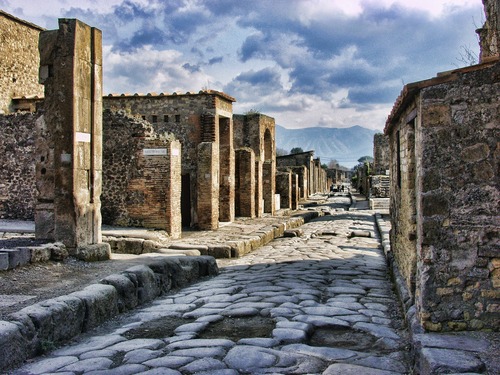 Via dell’Abbondanza was the main street in the town. It was lively with open bars and takeaways facing the street. On every corner a Subway and Starbucks of the day. Like a moment frozen in time, it really captures the imagination and brings history to life.
Via dell’Abbondanza was the main street in the town. It was lively with open bars and takeaways facing the street. On every corner a Subway and Starbucks of the day. Like a moment frozen in time, it really captures the imagination and brings history to life.
Wooden shades overhung the entrances providing relief from the blistering sun, and the rain today. A jumble of terracotta red roofs, this was a busy, thriving Roman town. Stepping stones enabled the good folk of Pompeii to cross the roads with ease – ye olde Pedestrian crossings, with gaps to allow carts to pass unhindered along the road.
It is a fallacy that the phallus was simply an erotic symbol. It is thought that in the Roman world it was also a symbol of good luck and happiness. No more erotic than hanging up a horseshoe. It was quite a common presence in the town, playfully carved or painted on the walls, or fashioned into oil lamps and objet d’art. The archaeological museum in Naples has a whole room full of such art.
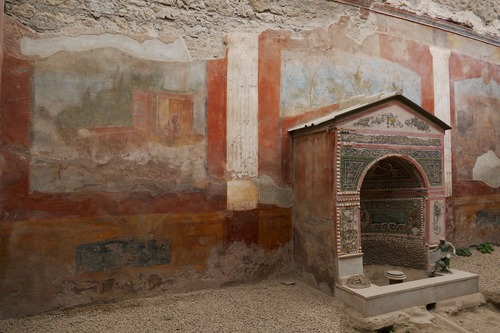 An attractive Italian lady had ‘L’ammore nun s’accata e nun se venne’ emblazoned across the front of her t-shirt. It translates as ‘you can’t buy or sell love’. Well maybe not love, but certainly in Pompeii you could buy sex. Plenty of it, in the Lupinare – the brothel. It is fascinating and the most popular attraction in the town.
An attractive Italian lady had ‘L’ammore nun s’accata e nun se venne’ emblazoned across the front of her t-shirt. It translates as ‘you can’t buy or sell love’. Well maybe not love, but certainly in Pompeii you could buy sex. Plenty of it, in the Lupinare – the brothel. It is fascinating and the most popular attraction in the town.
Above the five cubicles are painted images of sexual acts. Pictorial notice boards of the services on offer, perhaps? Or just ancient erotica, there to arouse prior to activities? An early Viagra maybe? A fascinating insight into Pompeii leisure time.
We finally began to tire a little after seeing so many amazing and thought-provoking things. Time for a rest. In deference to Mars, the Roman God of War, we ate one of his chocolate bars. It did the trick. The sun began to shine and the crowds began to thin out. Grazie.
More information
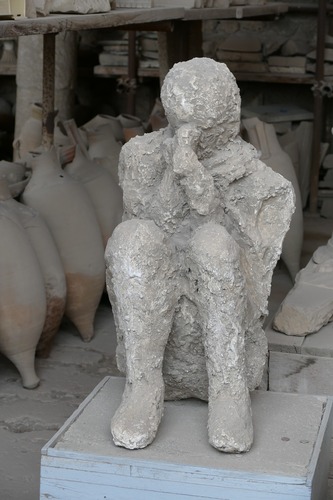 The best way to visit Pompeii is with a company that doesn’t rush you around but gives you the whole day to take it all in, with an expert guide to bring it to life, and with several days to explore the magnificent archaeology and scenery of the whole Bay of Naples, including Herculaneum, the National Archaeological Museum, and other fabulous sites.
The best way to visit Pompeii is with a company that doesn’t rush you around but gives you the whole day to take it all in, with an expert guide to bring it to life, and with several days to explore the magnificent archaeology and scenery of the whole Bay of Naples, including Herculaneum, the National Archaeological Museum, and other fabulous sites.
We recommend Hidden History Travel, who specialise in such tours and have a great itinerary with seven nights in a lovely hotel, daily excursions to all the main sites, and a knowledgeable tour director to help bring it all together. Their 2018 departures are on 28 April, 26 May and 7 September. And the price is from only £1,195 per person.
Visit www.hiddenhistory.co.uk for more details or call 0121 444 1854 to speak to an expert.











